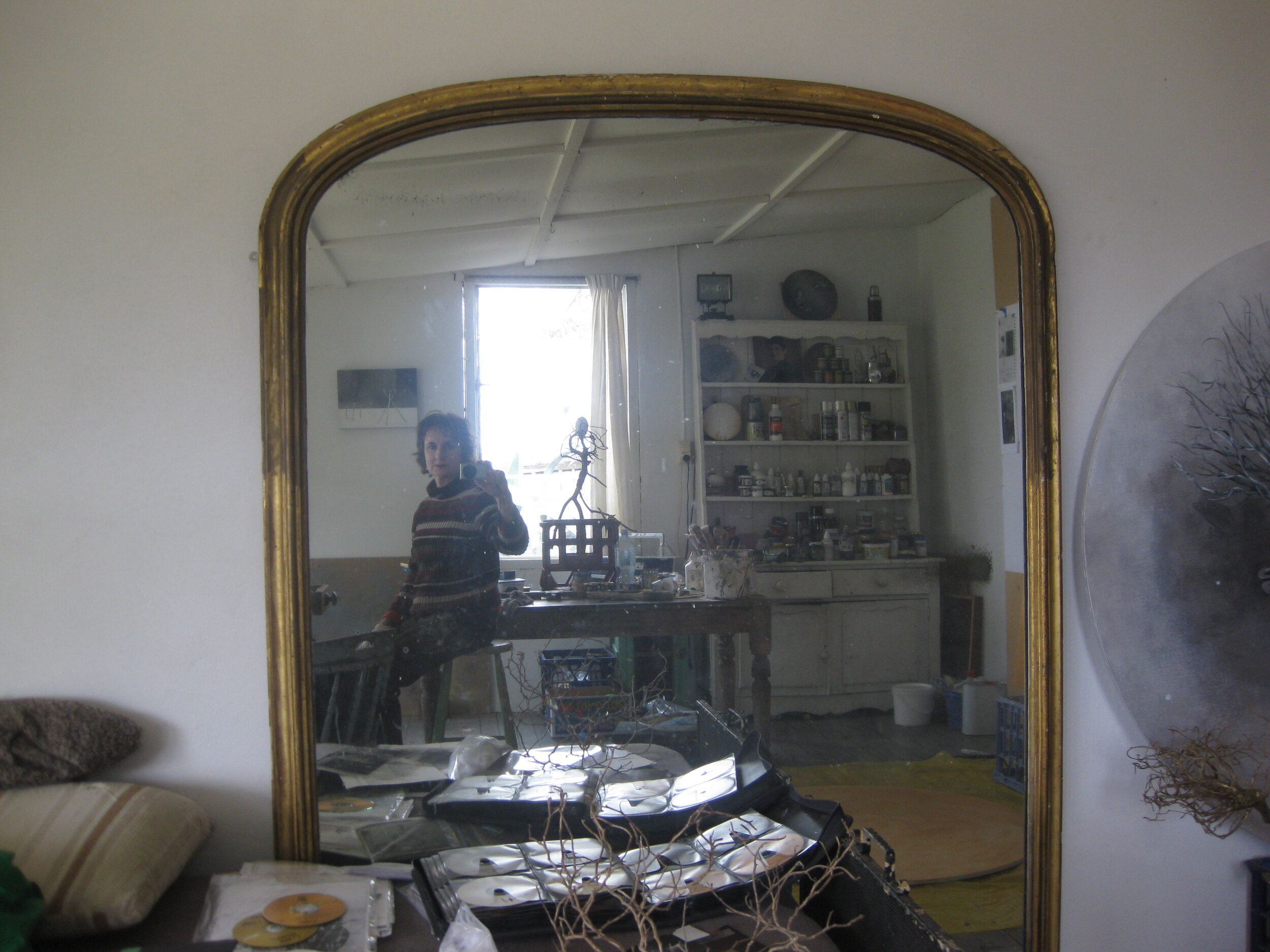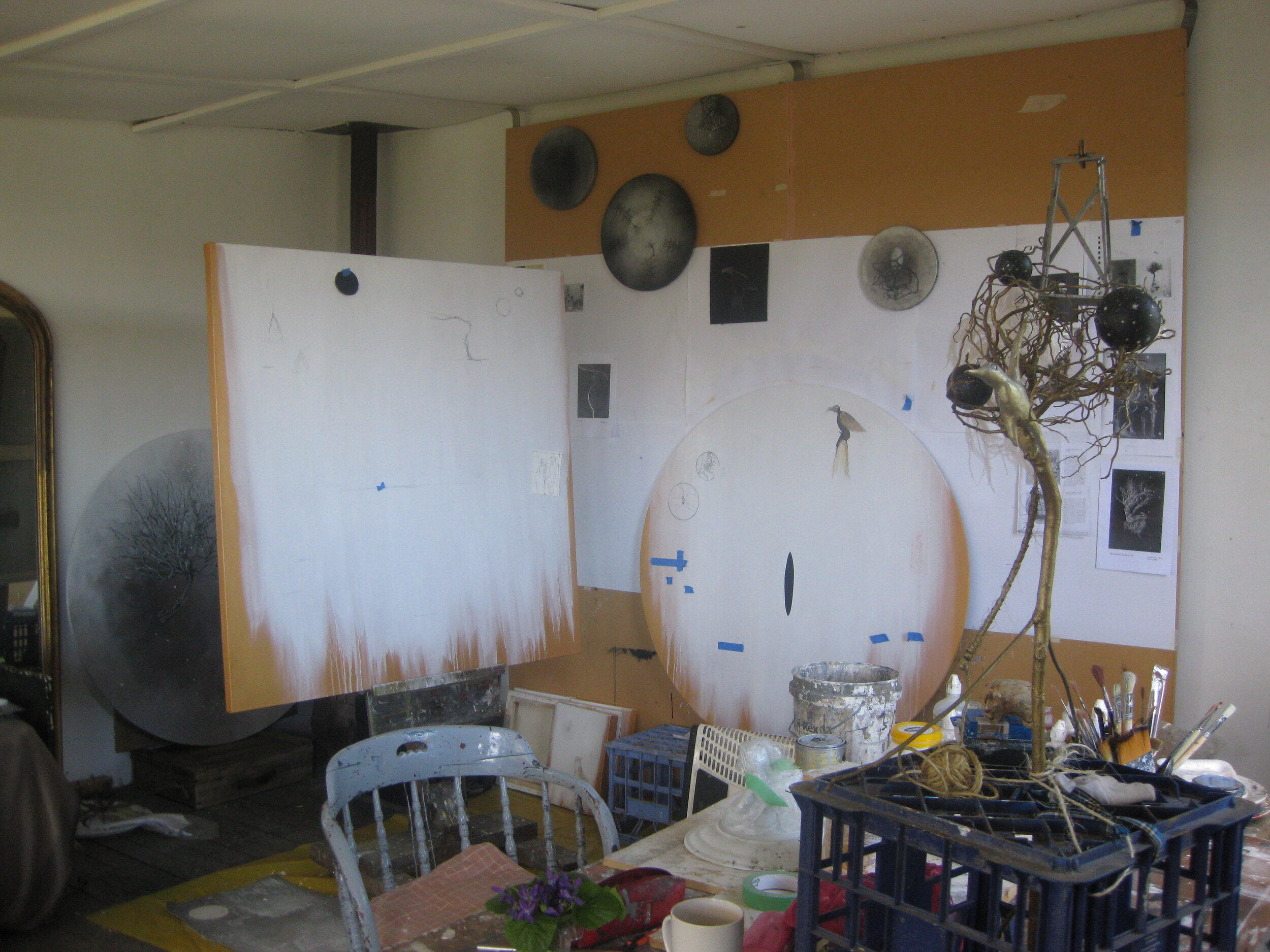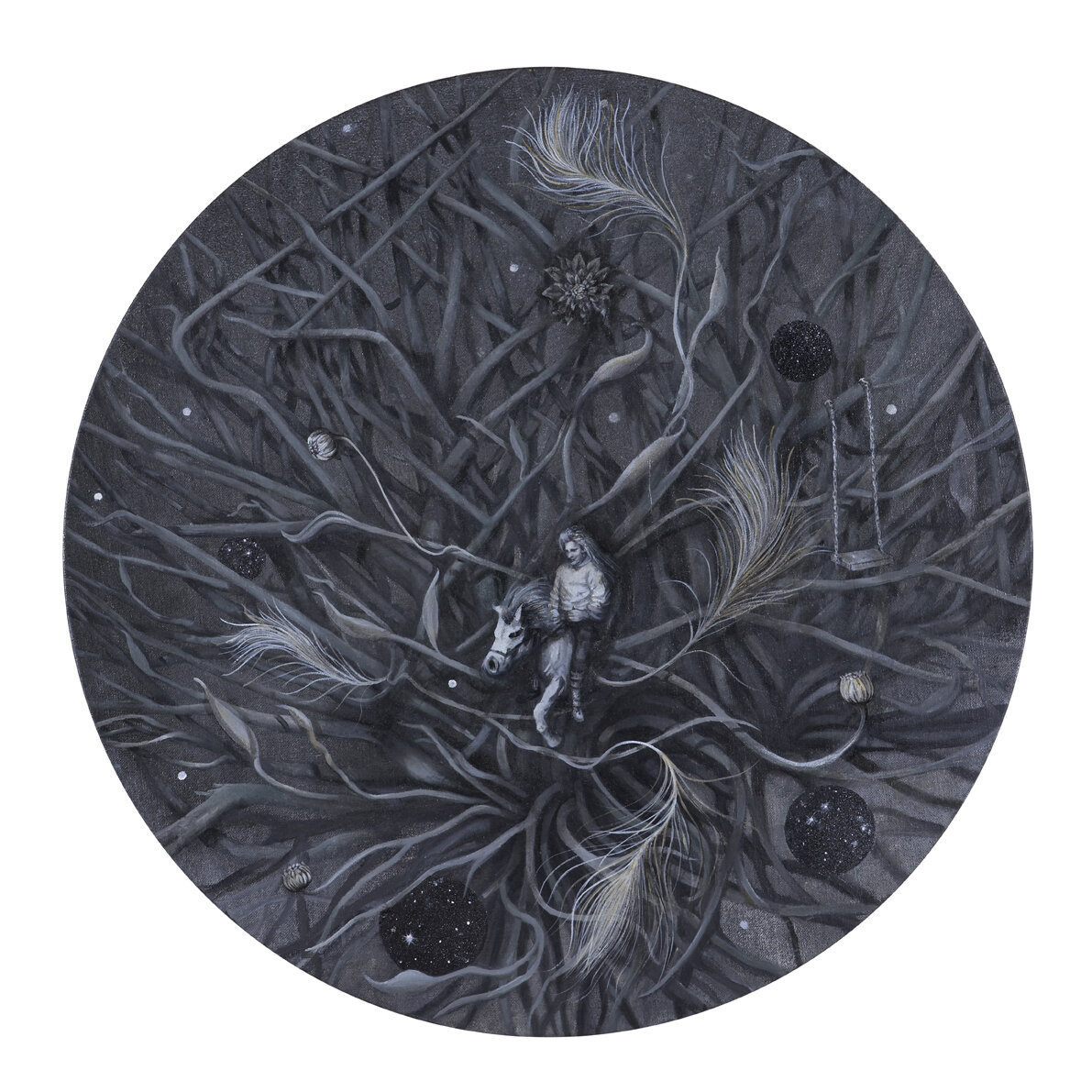2011 Colliding Worlds Depot 2 Gallery Waterloo, Sydney 8-19 March
Colliding Worlds, 2010 acrylic & oil on board 118 diameter _ artist's collection
DG2 Entry Installation View from Entry
Heed the Hesperides 2010 2010 acrylic, oil, chrome spray on Belgian linen _ sold
Great Wall meets Rabbit Proof Fence 2011 acrylic & oil on canvas panels mixed 20, 25, 29, 30 cm $7,000
DG2 Installation View 2 Left of Entry & Back Wall
The Silent Forest 2011 acrylic and oil on Belgian linen ( framed) 116 X 126 cm _sold
DG2 Installation View 3
DG2 Installation View 4
Under Grey Skies #1, 2009 acrylic, oil on canvas 50 x 50 cm _ sold
From Here to Where 2011 acrylic, found timber, feather, balsa wood, foam on mdf plinth & metallic spray paint 180 X 36 X 52 cm
Run Rabbit Run 2010 acrylic, oil on Belgian linen each painting 61 X 83 cm $8,000
While looking at Gabrielle Courtenay’s star speckled paintings the fragmented phrase, “To see a world in a grain of sand…” is gently unmoored from the depths of my memory and drifts unbidden into my mind. At first, I’m not entirely sure where it came from as this line, and others, from William Blake’s early 19th century poem Auguries of Innocence has seeped into our collective subconsciousness through steady repetition, quoted and misquoted by everyone from Agatha Christie, Bob Dylan, Jim Morrison and Sting, to fictional Tomb Raider Lara Croft and Nobody from Jim Jarmusch’s film Dead Man. In an instinctive moment of clarity, fed by a neat mobius strip of ever circulating influence in which literature, filtered through popular culture, finds its way into art, I’ve realised that the works in Colliding Worlds are visual poems.
Blake’s words highlight for me the poetic structural strategies of Courtenay’s paintings: the use of symbolism and metaphor, the judicious intermingling of fantasy and reality, the ability to evoke a certain slippery, intangible, yet powerful emotional response. The first stanza of Auguries of Innocence, “To see a world in a grain of sand and a heaven in a wild flower, hold infinity in the palm of your hand and eternity in an hour,” brings to light some of Courtenay’s underlying themes.
In Courtenay’s paintings, the world seems to have been reduced, in more ways than one. Colour has been drained away until all that remains is almost monochromatic: subtle shades of silver, grey, white, black and lavender. And in her imagery, whole planets appear to have been compressed, not in to grains of sand or wild flowers, but in to floating tangles of twigs, fish-eye landscapes studded with power pylons, or yawning voids full of glittering stars. Courtenay’s worlds are stripped back and miniaturised. Just as Blake describes, they read like microcosms of the larger macrocosm reflecting a Platonic notion, popular in European philosophy of the Middle Ages, which tried to theorise the place of mankind in the universe and acknowledged the interconnectedness of all things.
The title, Colliding Worlds, also provides an insight into Courtenay’s concerns. It speaks not just of the cataclysmic impact of crashing planets, but also of the clash of civilisations and the devastating repercussions of our ongoing struggle for dominance with the natural world.
In early 2010, Courtenay undertook a residency in Northern Beijing. There she encountered a bleak, wintry landscape, which is translated in her reduced colour palette. Her studio, adjacent to a power station, was covered everyday by a grimy black film of grit. She soon realised that this continuous sprinkling of pollution could easily have started its carbon cycle millions of years ago in Australia, first as living organisms, then as coal ripped from the earth and shipped across the seas. Burned as fuel in China, it settled as dust on the skin of an Australian a long way from home. Everything is connected and all actions have consequences.
Courtenay channelled this awareness in to her work. In her Great Wall Meets Rabbit Proof Fence series, she freely interlaces imagery gleaned from China with impressions from the Australian outback. Elsewhere, she seems to allude more generally to the disastrous and long reaching effects our actions can have in an interconnected eco-system. In Heed the Hesperides, the title, as well as a bold graphic symbol in the upper right quadrant, signals a warning. But just exactly what we need to look out for isn’t clear. The painting depicts a gnarled, leafless tree intertwined with a small boat, floating on grey water. Is the boat a parasite sucking sustenance from the body of the tree: culture greedily feeding off nature’s bounty and draining it dry? Or is the tree sprouting from the boat: nature vanquishing culture, reclaiming territory and starting a new cycle of life? Are we being warned against the hubris of humanity or the inexorable omnipotence of nature? Perhaps both.
The message in this painting, like the others in Colliding Worlds, is ambiguous. Gabrielle Courtenay uses symbolism and visual metaphor to elicit impressions that have a nebulous, shifting quality. Her artworks have embedded narratives, but they are not pedagogical. They don’t just tell one story with a predictable linear structure of beginning, middle and end. Rather, her paintings act as a catalyst, a trigger for the imagination. As in poetry, the viewer must complete the chain reaction by adding their own potent mix of emotion and intellect in order to create something ephemeral, volatile and mercurial.
Tracey Clement, Sydney, 2010
Bathurst Regional Art Gallery, Hill End Artist in Residence Program Haeflingers Cottage, Hill End 1-29 August“ Gabrielle Courtenay uses her work to explore our subliminal relationship with the land. Courtenay's recent work explores changes to the Australian landscape since colonial times, investigating the dialogues between the juxtapositions of nature and our architectural and fabricated surrounds. Courtenay sees Hill End as a unique location where the footprint of the past is still evident allowing the contemplation of an artistic dialogue between the past and present.”
Bathurst Regional Gallery Art Residency website 2011
Morning Haeflinger Cottage Hill End 2011
Self Portrait 2011 in Cottage's Studio
View from back garden early morning visitors
Remains of past in Hill End Village close to cottage
Studio View of works in progress
Early Mining Structure Remains in paddock close to Cottage
Back Cover "Golden Threads' Janis Wilton The Chinese in Regional NSW 1850-1950. Brought at Village Museum
Chinese miner outside home Hill End
Eroded Gully walk with Chinese miners evacuated mining shaft remains
Eroded Gully walls and the past labour of miners
Studio View drawing table
Studio View of sculptures in progress
'Meditation' 2012 painted Wunderkammer panel. 1880's grapevine carving of Guan Yin-goddess of Mercy- sourced from "Golden threads p91.
Following my 2010 Redgate Art Residency Bei Gao Studios, North Beijing I was very lucky in 2011 to be accepted by Bathurst Regional Gallery for a place in their Residency Program at Hill End at Haeflinger’s Cottage from the 1-29 August. I was overjoyed to be able to return to the cottage and create artwork in its Artist Studio. With my first Art Residency at Hill End 2004 being so pivotal to my artistic development. A small village isolated on the edge of cliffs set into the bush with the physical remains and haunting memories of the souls who toiled there and around the area in the search for gold in the 1850’s onwards.
My March residency in China and travelling to different cities in China had increased my interest sharpened my interest in Chinese culture its history and the scale of its economic transformation under the CCP into a major global power. But with it came an awareness of the global scale of man’s impact on the planet and the future reality of competing interests, clashing cultures imploding on the natural world, vying for the limited resources of our planet.
To immerse myself into Hill End’s unique landscape with its mining history I took a selection of art materials and studies from my Chinese residency and unfinished paintings for my upcoming October to November Colliding Worlds exhibition at Anita Traverso Gallery, Richmond Melbourne. Hill End’s museums provided displays and information on the history of Chinese miners who had lived and toiled evacuating into the surrounding hillsides searching for gold with others from over Australia & overseas. On walking my daily walking expeditions, sketching the landscape I collected tree forms, bird heads and abandoned nests to transform into artworks.
My 2004 Residency produced my White Lines series, minimal abstract paintings where the white line denotes my journey thru the landscape its colours denoting the energy and colours of the land. At Hill End 2011, I returned to making sculptures from drawings and found materials as well as completing paintings for my September art show. The Residency itself reinforced my future creative of process of enmeshing my work with found & collected imagery exploring past histories, affecting the present and future possibilities for the planet: making poetic, allegorical artworks informed by abstraction seeking spiritual connections.
Gabrielle Courtenay
Colliding Worlds Anita Traverso Gallery, Melbourne 28 Oct-19 Nov 2011
ATG Reception Gallery Entry
Under Grey Skies#2 2010 acrylic & oil on canvas 50 X 50 (framed) $2,200
Winter#1 2010 acrylic & oil on Belgian linen 31 X 36 cm _ sold
Winter#2 2010 acrylic & oil on Belgian linen 31 X 36 cm _sold
Winter#3 2010 acrylic & oil on Belgian linen 31 X 36 cm _ sold
Imagine 2011 acrylic & oil on board 118 cm diameter _ sold
ATG Installation View 2
The dance of the butterflies still moves in my heart 2011 acrylic & oil on Belgian linen on board 118 cm diameter _sold
Great Wall meets Rabbit Proof Fence 2009-11 Installation View Anita Traverso Galley, October 2011
ATG Installation View 4
Morning Star- whom the shadows cannot hold 2011 acrylic & oil on Belgian linen on board 75 cm diameter _ artist's collection
Run Rabbit Run 2011 typtich acrylic & oil on Belgian linen 83 X 61 cm each $7,000
ATG Installation View 5
ATG Installation View 7
While looking at Gabrielle Courtenay’s star speckled paintings the fragmented phrase, “To see a world in a grain of sand…” is gently unmoored from the depths of my memory and drifts unbidden into my mind. At first, I’m not entirely sure where it came from as this line, and others, from William Blake’s early 19th century poem Auguries of Innocence has seeped into our collective subconsciousness through steady repetition, quoted and misquoted by everyone from Agatha Christie, Bob Dylan, Jim Morrison and Sting, to fictional Tomb Raider Lara Croft and Nobody from Jim Jarmusch’s film Dead Man.
In an instinctive moment of clarity, fed by a neat mobius strip of ever circulating influence in which literature, filtered through popular culture, finds its way into art, I’ve realised that the works in Colliding Worlds are visual poems.
Blake’s words highlight for me the poetic structural strategies of Courtenay’s paintings: the use of symbolism and metaphor, the judicious intermingling of fantasy and reality, the ability to evoke a certain slippery, intangible, yet powerful emotional response. But the first stanza of Auguries of Innocence, “To see a world in a grain of sand and a heaven in a wild flower, hold infinity in the palm of your hand and eternity in an hour,” also brings to light some of Courtenay’s underlying themes.
In Courtenay’s paintings, the world seems to have been reduced, in more ways than one. Colour has been drained away until all that remains is almost monochromatic: subtle shades of silver, grey, white, black and lavender. And in her imagery, whole planets appear to have been compressed, not in to grains of sand or wild flowers, but in to floating tangles of twigs, fish-eye landscapes studded with power pylons, or yawning voids full of glittering stars. Courtenay’s worlds are stripped back and miniaturised. Just as Blake describes, they read like microcosms of the larger macrocosm reflecting a Platonic notion, popular in European philosophy of the Middle Ages, which tried to theorise the place of mankind in the universe and acknowledged the interconnectedness of all things.
The title, Colliding Worlds, also provides an insight in to Courtenay’s concerns. It speaks not just of the cataclysmic impact of crashing planets, but also of the clash of civilisations and the devastating repercussions of our ongoing struggle for dominance with the natural world.
In early 2010, Courtenay undertook a residency in Northern Beijing. There she encountered a bleak, wintry landscape that is translated in her reduced colour palette. Her studio, adjacent to a power station, was covered everyday by a grimy black film of grit. She soon realised that this continuous sprinkling of pollution could easily have started its carbon cycle millions of years ago in Australia, first as living organisms, then as coal ripped from the earth and shipped across the seas. Burned as fuel in China, it settled as dust on the skin of an Australian a long way from home. Everything is connected and all actions have consequences.
Courtenay channelled this awareness in to her work. In her Great Wall Meets Rabbit Proof Fence series, she freely interlaces imagery gleaned from China with impressions from the Australian outback. Elsewhere, she seems to allude more generally to the disastrous and long reaching effects our actions can have in an interconnected eco-system. In Heed the Hesperides, the title, as well as a bold graphic symbol in the upper right quadrant, signals a warning. But just exactly what we need to look out for isn’t clear. The painting depicts a gnarled, leafless tree intertwined with a small boat, floating on grey water. Is the boat a parasite sucking sustenance from the body of the tree: culture greedily feeding off nature’s bounty and draining it dry? Or is the tree sprouting from the boat: nature vanquishing culture, reclaiming territory and starting a new cycle of life? Are we being warned against the hubris of humanity or the inexorable omnipotence of nature? Perhaps both.
The message in this painting, like the others in Colliding Worlds, is ambiguous. Gabrielle Courtenay uses symbolism and visual metaphor to elicit impressions that have a nebulous, shifting quality. Her artworks have embedded narratives, but they are not pedagogical. They don’t just tell one story with a predictable linear structure of beginning, middle and end. Rather, her paintings act as a catalyst, a trigger for the imagination. As in poetry, the viewers must complete the chain reaction by adding their own potent mix of emotion and intellect in order to create something ephemeral, volatile and mercurial.
Tracey Clement
Sydney, 2010






































